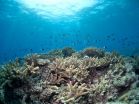(Press-News.org) Marine scientists keen on finding patterns of coral decline and persistence in gradually warming oceans have a complex challenge: how to save reefs containing the most diversity with limited resources. In the Western Indian Ocean, researchers from the Wildlife Conservation Society, the University of Warwick, the ARC Centre for Excellence of Coral Reef Studies, Simon Fraser University, University of North Carolina at Chapel Hill, and other groups have found that the corals of the Mozambique Channel should be a priority for protection as climate change continues to threaten these rainforests of the sea.
The study—generated from data gathered from nearly 300 marine sites over thousands of square miles of ocean—is the latest attempt by scientists to improve efforts to first identify reefs that have survived the effects of higher temperatures and sometimes human pressures such as fishing, and then actions best suited to protecting less disturbed coral ecosystems.
The study appears today in the online journal PLOS ONE. The authors are: Tim McClanahan and Nyawira Muthiga of the Wildlife Conservation Society; Mebrahtu Ateweberhan of the Wildlife Conservation Society and the University of Warwick, United Kingdom; Emily Darling of the Earth to Ocean Research Group at Simon Fraser University and the University of North Carolina at Chapel Hill; and Nicholas Graham of the ARC Centre of Excellence for Coral Reef Studies, James Cook University, Australia.
"Determining which reef systems possess a measure of resistance to climate change requires knowing how they have survived the many recent climatic disturbances" said Tim McClanahan, WCS's Senior Conservation Scientist and lead author of the paper. "The Western Indian Ocean provides us with a variety of responses to disturbances that we can examine and distinguish environmental variation, resilience, adaptation, and other factors for a more informed view of management priorities and solutions to the climate crisis."
Working in 11 countries over a 7-year period, the research team surveyed a total of 291 coral reef sites to evaluate the variations in coral communities. Part of the study was to gauge the recovery of corals since 1998, the year of a massive warming event fuelled by the El Niño Southern Oscillation that caused massive bleaching in the region but also a series of lesser warming events that have disturbed the region since 1998.
The researchers worked in many sites along the African coastline as well islands such as the Maldives, the Seychelles, Comoros, Mauritius, Reunion, and others. The data collection efforts used two research methods for the study, the first being randomly placed 10-meter lines (known as line transects), where scientists identified the kinds of coral down to genus. The other method—known as a roving observer survey—involved the researcher identifying every coral within a randomly located 2-square-meter polygon. The scientists also recorded levels of observed bleaching during the surveys.
The main finding of the study, the authors note, is the unique conditions of the northern Mozambique Channel—a confluence of tides, currents, eddies, along with less exposure to waves and storms—that seem to protect the channel's high coral richness. High coral diversity and sensitive species have disappeared from many other sites sampled during the project.
Aside from the discovery of the Mozambique Channel as a conservation priority, the scientists found that the latitude where the reef systems are located determined the types of corals found. Northern coral reefs (closer to the equator) in coastal Kenya, Seychelles, and the Maldives—sites greatly impacted by the 1998 bleaching event—contained fewer temperature sensitive species (Acropora and Montipora) and more corals resistant to warm water disturbances.
The scientists examined fishing closures or marine protected areas and found that these no-take areas may promote higher percentages of coral cover prior to a bleaching event, but seem to have no measurable effect on reef recovery after such an occurrence. This suggests the location of the protected areas is critical and they should be placed in areas where corals are surviving, such as Tanzania, Mozambique, and northern Madagascar.
"The remaining coral diversity of the Mozambique Channel presents us with an opportunity to safeguard these remaining ecosystems for posterity," said Dr. Caleb McClennen, Director of the WCS Marine Program.
INFORMATION:
There are plans to do just this with the formation of the Consortium for the Conservation of Coastal and Marine Ecosystems in the Western Indian Ocean (WIO-C), a group of international and regional NGOs in partnership with intergovernmental organizations active in regional marine and coastal ecosystem management. To visit the WIO-C site, go to:
http://www.wiomsa.org/wioc/
Research by WCS was made possible by the generous support of the Western Indian Ocean Marine Science Association (WIOMSA) Marine Science for Management Program (MASMA) program, the John D. and Catherine T. MacArthur Foundation, and the Coral Reef Targeted Research Group (World Bank). Work in the Seychelles was made possible by the Department for International Development of the United Kingdom and Leverhulme Trust.
Coral reefs of the Mozambique Channel a leading candidate for saving marine diversity
2014-04-10
ELSE PRESS RELEASES FROM THIS DATE:
Reef fish arrived in 2 waves
2014-04-10
The world's reefs are hotbeds of biological diversity, including over 4,500 species of fish. A new study shows that the ancestors of these fish colonized reefs in two distinct waves, before and after the mass extinction event about 66 million years ago that wiped out the dinosaurs.
Reef fish represent one of the largest and most diverse assemblages of vertebrates, according to Samantha Price, a postdoctoral researcher in the Department of Evolution and Ecology at UC Davis. Price is first author on a paper describing the work, published April 2 in the journal Proceedings ...
CU researchers unraveling what's behind the sniffles, hoping for a treatment
2014-04-10
Scientists at the University of Colorado School of Medicine have shed light on one of the most common of ailments – the runny nose.
Your respiratory tract is under constant attack and the nose is the first line of defense. Often, especially as the weather warms, the assault comes from allergens, which cause the body to fight off a perceived threat. Infections, too, are a problem.
But millions of people get a runny nose and have difficulty breathing without an allergic attack or infection. What many people call the sniffles, scientists refer to as "non-allergic rhinitis."
Although ...
China looks to science and technology to fuel its economy
2014-04-10
Maintaining stability in the face of rapid change and growth, and proactively partaking in cooperative global ties in science and technology fields will be key in helping China become an innovation-based economy, according to Denis Simon, vice provost for International Strategic Initiatives at Arizona State University.
One of the world's leading experts on science, technology and innovation in China, Simon recently hosted an ASU conference that focused on the evolving role of science and technology in China's international relations.
Supplemented with strategic investments ...
Researchers looking to create new bone tissue generation technique
2014-04-10
UT Arlington and Texas Health Arlington Memorial Hospital are investigating whether bone grown from the body's own stem cells can replace traditional types of bone grafting.
The process, which has been successful in previous lab experiments, uses biodegradable polymer scaffolding material and bone morphogenetic protein, or BMP, which was inserted into the abdomen of mice to attract stem cells that in turn produced bone. BMPs are proteins known to promote bone growth. The research is detailed in a new paper, "Tissue Engineering Bone Using Autologous Progenitor Cells in ...
La Brea Tar Pit fossil research shows climate change drove evolution of Ice Age predators
2014-04-10
LOS ANGELES — Concerns about climate change and its impact on the world around us are growing daily. New scientific studies at the La Brea Tar Pits are probing the link between climate warming and the evolution of Ice Age predators, attempting to predict how animals will respond to climate change today.
The La Brea Tar Pits are famous for the amazing array of Ice Age fossils found there, such as ground sloths, mammoths, and predators like saber-toothed cats and powerful dire wolves. But the climate during the end of the Ice Age (50,000-11,000 years ago) was unstable, ...
Acupuncture normalizes brain structure and damaged neurons following heroin relapse
2014-04-10
Heroin abuse can damage many brain areas, including the pedunculopontine tegmental nucleus of the midbrain, the ventral tegmental area, and nucleus accumbens. Persistent use of heroin induced irreversible damage to the nervous system. To verify the relationship between acupuncture, neurotrophic factor expression and brain cell structural changes, a research team from Anhui University of Chinese Medicine in China established a rat model of heroin relapse using intramuscular injection of increasing amounts of heroin. During the detoxification period, rat models received acupuncture ...
Brainy courage of the rainbowfish
2014-04-10
The boldest black-lined rainbowfish are those that are born in the wild. Also more fearless are those that analyze information both sides of their brains. This is the conclusion of Australian researchers Culum Brown and Anne-Laurence Bibost from Macquarie University, in a study published in Springer's journal Behavioral Ecology and Sociobiology.
The preference to analyze and react to information with either the left or right hemisphere of the brain is called cerebral lateralization, and is widespread among vertebrates. Lateralization is seen in the preference of humans ...
Identified epigenetic factors associated with an increased risk of developing cancer
2014-04-10
In 10% of human tumors there is a family history of hereditary disease associated with mutations in identified genes. The best examples are the cases of polyps in the large intestine associated with the APC gene and breast cancer associated with BRCA1 and BRCA2 genes. In the remaining 90% of cases are believed to have an increased risk of developing cancer in relation to genetic variants less powerful but more often, for example, doubles the risk of having a tumor that lacks this small change, called polymorphism.
In the last decade, hundreds of studies have been conducted ...
Experts disagree on horses with incoordination
2014-04-10
A trip to the veterinarian may prove fatal to a horse, even if it is not necessary to put the animal down. In Europe if the horse is found to be ataxic, which is most often due to the disease 'wobbler syndrome', the horse is likely to be put down immediately. If a horse suffers from this disease, putting it down can be a necessity, as the animal can be dangerous to ride and handle. But now new research from the University of Copenhagen and the Royal Veterinary College in the UK shows marked disagreement among experts about when a horse is ataxic and severity of the ataxia. ...
Proof that antidepressants and breastfeeding can mix
2014-04-10
University of Adelaide researchers have found that women on antidepressant medication are more successful at breastfeeding their babies if they keep taking the medication, compared with women who quit antidepressants because of concerns about their babies' health.
These results have been presented this week at the 18th Perinatal Society of Australia and New Zealand (PSANZ) Annual Conference in Perth.
Using data from the Danish National Birth Cohort in Denmark, researchers in the University of Adelaide's Robinson Research Institute studied the outcomes of 368 women who ...



